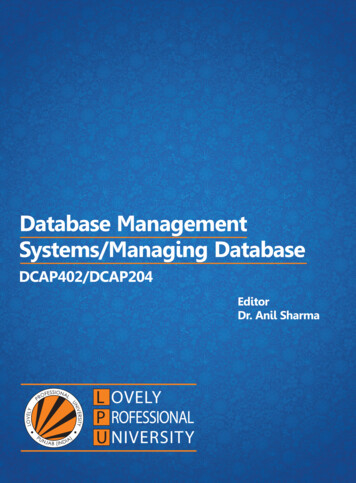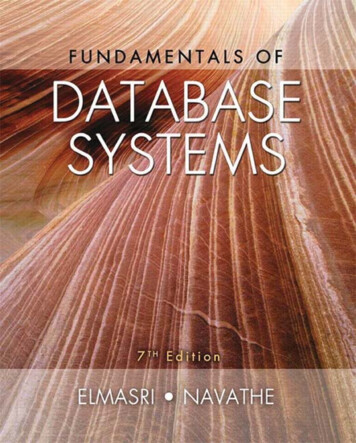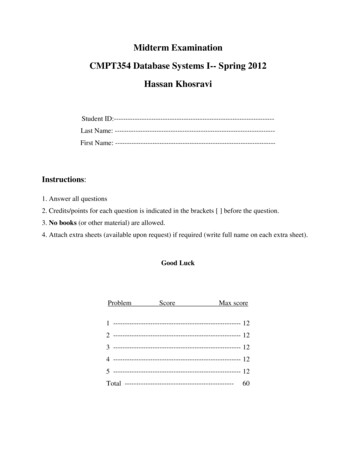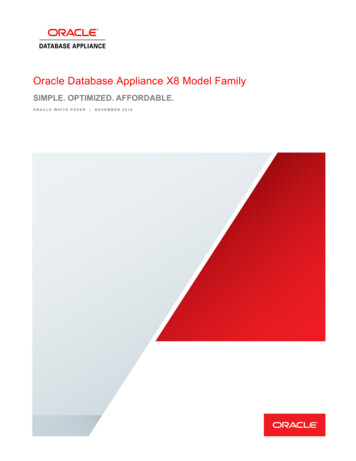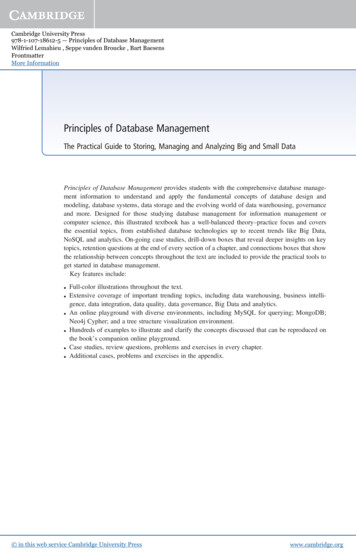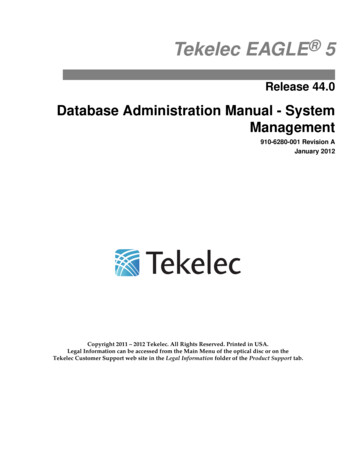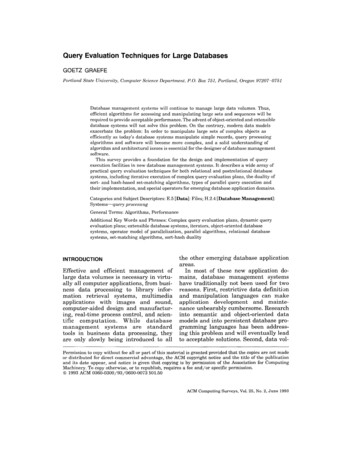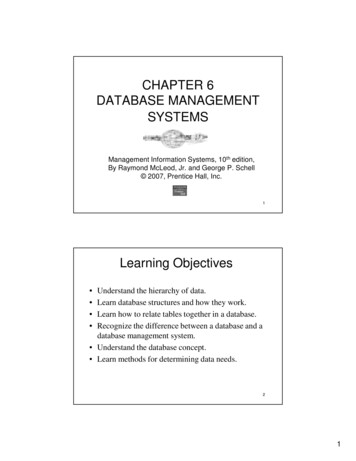
Transcription
CHAPTER 6DATABASE MANAGEMENTSYSTEMSManagement Information Systems, 10th edition,By Raymond McLeod, Jr. and George P. Schell 2007, Prentice Hall, Inc.1Learning Objectives Understand the hierarchy of data.Learn database structures and how they work.Learn how to relate tables together in a database.Recognize the difference between a database and adatabase management system. Understand the database concept. Learn methods for determining data needs.21
Learning Objectives (cont.) Understand the basic differences betweenstructured query language and query-by-example. Learn about reports and forms. Become familiar with entity-relationship diagramsand class diagrams. Learn about the important personnel who areassociated with databases. Learn the advantages and costs of databasemanagement systems.3Introduction Database management systems organize thelarge volume of data that firms use in theireveryday business activities The data organization must also allowmanagers to find specific data easily andquickly for decision making The increased importance of databases asresources supporting decision making hasrequired managers to learn more aboutdatabase design and use42
DATA ORGANIZATION Firms need very large amounts of data stored intheir computer-based information systems simplybecause they conduct so many business transactions So much data exists that it would be useless forbusiness decision making without an effective andefficient manner for organizing the data In order to use the data and avoid chaos, the “data”concept has to be broken down and reduced tosmaller concepts These smaller concepts of data form the buildingblocks that can be combined to reproduce theoriginal data in an organized, accessible format5The Data Hierarchy Business data is organized into a hierarchy of:– data fields that combine to form records; and– records that combine to form database files A data field is the smallest unit of data representingthe smallest amount of data that might be retrievedfrom a computer at a given time A record is a collection of related data fields A file is a collection of related records, such as a fileof all records containing course codes and title fields Table 6.1 shows an example of a database file63
7The Spreadsheet As a Simple Database A table of rows and columns can berepresented in a spreadsheet The columns of the spreadsheet representthe data fields while the column headingscontain data field names Rows of the table contain the field values Figure 6.1 illustrates an Excel spreadsheetcontaining the values from the COURSEtable shown in Table 6.184
9Flat Files A flat file is a table that does not have repeatingcolumns A flat file provides the constant sequence of datafields that database management requires Flat files allow relational database structures to benormalized Normalization is a formal process for eliminatingredundant data fields while preserving the ability ofthe database to add, modify, and delete recordswithout causing errors105
11Key Fields Table 6.3 depicts values in the BOOK table andillustrates the concept of a key The key in a table is a field (or combination offields) which contains a value that uniquelyidentifies each record in the table A single field often serves as a key for a table. Distinguishing between two or three rows is notenough, key values must be unique for the entiretable A candidate key is a field that uniquely identifieseach table row but was not chosen to be the key126
13Key Fields (cont.) Some tables require the values of two or morefields to uniquely identify each row in the table An example would be when courses have projects Table 6.4 shows projects but note that no singledata field value uniquely identifies each row Values in the Code field column repeat betweenrows. So do field values in all other columns The combined values in the Code and Numberfields, however, do form a unique value147
Relating Tables Sometimes it may be necessary to join tables thatoriginally stand alone Consider Table 6.5, the DEPARTMENT table. Itshows the six departments offering the courses inthe COURSE table Note that the tables have no column in common. You might be able to guess which departmentoffered each course based upon the values in theAbbreviation field but a computer needs an exactmatch, not a guess Table 6.6 depicts the COURSE table with theAbbreviation added15168
17189
DATABASE STRUCTURES Database structures are ways of organizing datain order to make data processing more efficient The structure is then implemented via adatabase management system (DBMS)which is a software application that:– stores the structure of the database;– stores the data itself;– stores the relationships among data in thedatabase;and– forms and reports pertaining to the databaseincluding the data field description Because it contains the data field definitions,the database controlled by a DBMS is called a“self-describing set of related data”19Hierarchical Database Structures The IDS database management systemwas one of the first DBMS and conformedto the hierarchical database structure The hierarchical structure is formed bydata groups, subgroups, and furthersubgroups Figure 6.2 shows navigation from theDEPARTMENT table to the COURSEtable using a hierarchical databasestructure2010
21Network Database Structures Network database structures were developed toallow retrieval of specific records They allow any given record to point to any otherrecord in the database Networks solve the problem of having to backtrackall the way to a joining “branch” of the database However, this wide range of possible connectionsis also the weakness of applying network structuresto practical problems since it was just too complexto allow every record to point to every other record2211
Relational Database Structures The breakthrough came from basic researchconducted independently by C. J. Date and E. F. Coddusing relational algebra They were able to show that relational databasescreated out of a series of interrelated tables were, infact, far more flexible and versatile than either thehierarchical or network database structures Whereas the hierarchical and network databasestructures rely on physical relationships in the formof storage addresses, relational database structures useimplicit relationships that can be implied from thedata (see Figure 6.3)232412
A RELATIONAL DATABASEEXAMPLE A database named Schedule has beencreated from tables used earlier in thechapter and some others The database is implemented in MicrosoftAccess 2002 (also known as Access XP). Databases break information into multipletables because if information were stored ina single table, many data field values wouldbe duplicated25The Schedule Database The example is implemented on Microsoft Access dbmsbut would be similar on any relational dbms product The COURSE table in Access (Figure 6.4) is a list ofdata field values. The table itself had to be defined inAccess before values were entered into the data fields Figure 6.5 shows the definition of the Code field Figure 6.6 illustrates that Abbreviation field values willbe looked up from a list of values in theDEPARTMENT table Table 6.7 shows a single table of course and departmentfields before they were separated into different tables2613
272814
293015
31The Database Concept The logical integration of records across multiplephysical locations is called the database concept. It isnot dependent on the user's perception of logicallocation Two primary goals of the database concept are tominimize data redundancy and to achieve dataindependence Data independence means placing the dataspecifications in tables and dictionaries that arephysically separate from the programs Data dictionary refers to the definition of data storedwithin the database and controlled by the DBMS 3216
CREATING A DATABASE In the conceptual model you:– Determine the data that you need– Describe the data– Enter the data into the database33Determine the Data NeedsThe two main approaches to determine data needs are: The Process-Oriented Approach:––––– The Enterprise Modeling Approach– 1. The problem is defined2. The decisions required to solve the problem areidentified3. For each decision the required information isdescribed4. The processing necessary to produce the informationis determined5. The data required by the processing is specifiedthe firm’s entire data needs are determined and thenstored in the databaseThe enterprise data model is shown in Figure 6.83417
35Data Modeling Techniques Modeling the firm's data needs is supported bytechniques that: Describe the data Describe how the data aggregates into tables Describe how tables relate to each other Entity-relationship diagrams are used to describerelationships between conceptual collections of dataso that their related records can be joined together Class diagrams are used to describe both the datarelationships and the actions that operate on the datain the relationships3618
Entity-Relationship Diagrams ER Diagrams deal with data in entities (conceptualcollections of related data fields) and the relationshipsbetween entities If we need to describe the data needed for a new informationsystem to keep track of firms and their employees as well astheir products, we can imagine that three separate dataentities will exist: firm, employee, and product (Figure 6.9) When firms hire employees, however, there is an independentrelationship between those two entities (Figure 6.10) Figure 6.11 demonstrates how we specify that one record inthe firm entity can be related to many records in the productentity and also that one record in the firm entity can relate tomany records in the employee entity Figure 6.12 is a “many-to-many” example373819
394020
41Class Diagrams When both the data used in an application and theactions associated with the data can be graphicallyrepresented they are called class diagrams andthey are one of several object-oriented designmodels Class diagrams consist of the named class, fieldsin the class, and actions (sometimes referred to asmethods) that act upon the class The class diagram in Figure 6.13 illustrates theentity-relationship diagram we have justcompleted4221
43USING THE DATABASE Consider a database on a personal computer Forms, reports, and queries are commonmethods for accessing the database held in adatabase management system A query language is the means for askingquestions of the database Many database management systemsprovide an easy-to-use interface for the user4422
Reports and Forms The majority of users' interactions with databasesare via reports and forms Graphical user interfaces (GUIs) are provided bymost database management software vendors tomake the development of forms and reports easier The greatest difference between forms and reportsis in their format Figure 6.14 shows a form for entering courses intothe database Figure 6.15 illustrates a form and subformcombination454623
47Reports and Forms (cont.) Reports are aggregated database data formatted in amanner that aids decision making Figure 6.16 is a report that shows each departmentwith a list of each course taught and projects requiredfor the course Figure 6.17 illustrates that the DEPARTMENT tablerelates down to the COURSE table which, in turn,relates down to the PROJECT table Unless there was a related entry in the PROJECTtable, no COURSE record was displayed. If no recordfrom the COURSE table was used (for example,neither economics course had a project) then aDEPARTMENT record was not displayed4824
495025
Query-by-Example Some users wish to go beyond reports and forms todirectly ask questions of the database A query is a request for the database to displayselected records and generally selects a limitednumber of data fields, then constrains the records toa set of criteria Figure 6.18 represents how that query could berepresented The format is called query-by-example (QBE)because the DBMS software presents a standardizedform that the user completes so that the system cangenerate a true query The result of the query is the table in Figure 6.19515226
Query-by-Example (cont.) Structured query language (SQL) is the code thatrelational database management systems use toperform their database tasks While the user may see Figure 6.18 as the QBE, thisis actually translated by database management systeminto the structured query language example shown inFigure 6.20 DBMS software contains graphical user interfacesand "wizard" programs to walk users through queriesin a user friendly manner Online analytical processing (OLAP) is anotherfeature becoming more common in databasemanagement system software535427
MANAGING THE DATABASE Database management systems performfunctions that most users never see The infrastructure is needed so that thedatabase can be maintained and modifiedand also to assure its efficient operation55Resources The performance statistics processor componentof the DBMS maintains information that identifieswhat data is being used, who is using it, when it isbeing used, and so forth As the database management system runs, it keepsa transaction log that notes every database actiontaken as well as the exact time the action wastaken A backup copy of the database is also madeperiodically5628
Database Personnel The database administrator (DBA) hasboth technical and managerialresponsibilities over the database resource. Database programmers create the databseapplications required by firms for theircorporate use The database end-user, by virtue of thedecisions made and the amount of dataretrieved, also has a major impact ondatabase design, use, and efficiency57DATABASE MANAGEMENTSYSTEMS IN PERSPECTIVE The DBMS makes it possible to create a database,maintain its contents, and disseminate the data to awide audience of users without costly computerprogramming Its ease of use allows managers and professionalstaff to access database contents with only modesttraining Every facet of information technology has bothadvantages and disadvantages and databasemanagement systems are no exception5829
DBMS Advantages and Disadvantages The DBMS enables both firms and individualusers to:– Reduce data redundancy– Achieve data independence– Retrieve data and information rapidly– Improve security A decision to use a DBMS commits a firm oruser to:– Obtain expensive software– Obtain a large hardware configuration– Hire and maintain a DBA staff59END OF CHAPTER 66030
database;and – forms and reports pertaining to the database including the data field description Because it contains the data field definitions, the database controlled by a DBMS is called a “self-describing set of related data” 20 Hierarchical Database Structures The IDS database man
